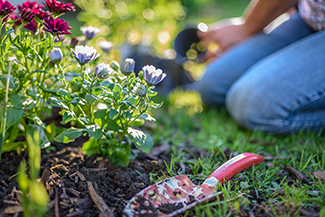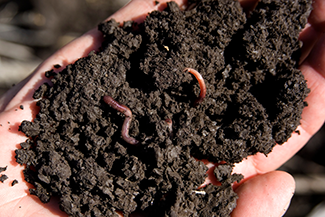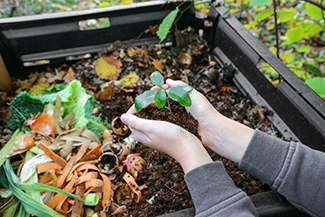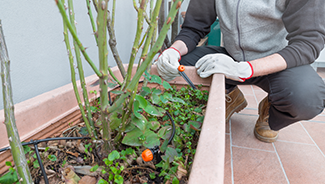Starting Your Spring Garden
#SpringGarden | #SuccessfulSoil
Farmer Greg Peterson of the Check out our weed killer recipe talks about starting your #SpringGarden and #SuccessfulSoil
Growing Healthy Soil
Growing Healthy Soil is the most important thing you can be doing
 We have less than 1% organic matter in desert soil
We have less than 1% organic matter in desert soil
- THAT is a huge problem
- The heat does a pretty good job of depleting it
- Healthy Soil Profile:
- Topsoil
- Subsoil
- Parent material
- The bad news is, all we have here in the desert is typically parent material, BUT that is fixable
- Healthy Soil:
- Holds water like a sponge
- At the interface between woody mulch and dirt the soil building begins very quickly
- Holds massive amount of life that helps your plants thrive
- There is a natural process that goes on in healthy soil that works in conjunction with the plants to make them healthier
5 Components of Healthy Soil
- Dirt
- Airspace
- Water
- Organic Matter
- And everything that is alive in the soil, like:
- Gophers, earthworms, moles, grubs, centipedes, millipedes, snails, slugs, beetles, ants, insect larvae, mushrooms, etc.

- Gophers, earthworms, moles, grubs, centipedes, millipedes, snails, slugs, beetles, ants, insect larvae, mushrooms, etc.
According to S.A. Waksman, a microbiologist, in just ¼ teaspoon of fertile soil you could find:
- 50 nematodes
- 62,000 algae
- 72,000 amoebae
- 2,920,000 actinomycetes; and
- 25,280,000 bacteria!
Go chemical free completely. The chemicals in weed suppressants and chemical fertilizers have a significant negative effect on the soil health
- If you are looking for a simple way to control the weeds on your property, we have one! Check out our weed killer recipe.
Different Types of Organic Matter
- Planting Mix
- Local Compost
- Woody Mulch
Difference between compost and mulch
 Yes, there is a difference and it's one of the biggest distinctions to learn
Yes, there is a difference and it's one of the biggest distinctions to learn
- Compost is decayed/decomposed organic matter. You can compost anything from lawn and yard clippings, kitchen scraps like fruit and veggie waste, etc. You can then add that compost when it’s ready (composting takes time) as a 50-50 mix with the soil; this will help improve the overall quality/nutrients of the soil to benefit your plants.
- Mulch is a little simpler than compost. Mulch is still organic matter but unlike compost, it is placed on top of the soil; this acts as a protective covering against the elements. Living in Arizona, we all know how harsh the sun can be for anything it touches, especially our lovely plants. Adding mulch to your plants will help with wind/rain erosion, provides a bit of insulation, and even locks in moisture.
Local Sources for Mulch, planting mix, compost and worm castings:
- ChipDrop.com
- ArizonaWormFarm.com
- Tanks in Tucson – Including Farmer Greg's Planting Mix
- Summer Winds – Tatum
- Barry's True Value
Healthy Soil Garden Hacks

Tune-In below for more information on:
- Lasagna or Sheet Mulch Gardening
- Why you might let the weeds arrive
- Parri's Box Garden
- Jan's Instant Garden
- Visit HealthySoilHacked.com for some great videos on growing healthy soil
Tried and True Garden Soil Recipe
Ingredients:
For every 100 sq ft (10x10)
- 6 bags of 1.5 - 2.0 cubic ft of good quality compost material
- 10lbs of gypsum
- 1-2 lbs of soil sulfur
- Approximately 5lbs of a good quality organic fertilizer; like Hickman's farms choice or you can blend 2-3 lbs of blood meal and 4-5 lbs of bone meal together.
Directions:
- This should be tilled into about 12" in depth and watered well one time before planting.
- Continue to fertilize with the organic fertilizer of your choice every 30 days or so.
- This process should be repeated every season just prior to planting.
Podcast
Farmer Greg preaches the NUMBER ONE THING for successful gardens and trees is creating healthy soil! Learn the 5 components of healthy soil and how some animals, insects and even weeds contribute to those components. We discuss the difference between compost and mulch and its proper use, plus, how to create your own compost, etc. because food tastes better when it's grown with healthy soil!
__________
Spring means getting your garden growers in the ground. Farmer Greg discusses how observing your space and sun exposure is important to start. Microclimates, watering, explaining how stacking functions works to your advantage, building healthy soil plus an explanation on the 3 types of seeds.
###
Photo Credit
- Shutterstock
Related Content
- DIY FAQ: Spring Vegetables and Flower Gardens
- DIY FAQ: Creating A Lush Landscape Without Excessive Water Usage
- DIY FAQ: Weed Killer Recipe
